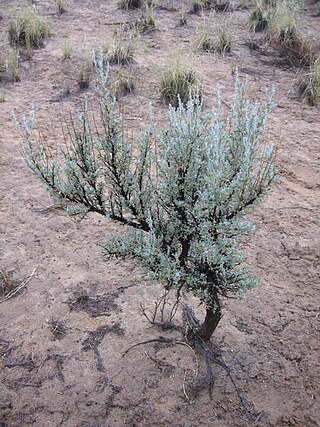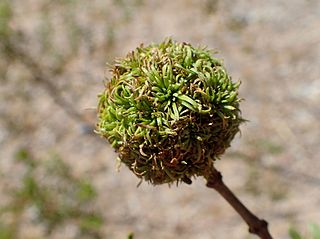
Larrea tridentata, called creosote bush and greasewood as a plant, chaparral as a medicinal herb, and gobernadora in Mexico, due to its ability to secure more water by inhibiting the growth of nearby plants. In Sonora, it is more commonly called hediondilla; Spanish hediondo = "smelly".

Larrea is a genus of flowering plants in the caltrop family, Zygophyllaceae. It contains five species of evergreen shrubs that are native to the Americas. The generic name honours Bishop Juan Antonio Hernández Pérez de Larrea, a patron of science. South American members of this genus are known as jarillas and can produce fertile interspecific hybrids. One of the more notable species is the creosote bush of the southwestern United States and northwestern Mexico. The King Clone ring in the Mojave Desert is a creosote bush clonal colony estimated to be about 11,700 years old.

Artemisia tridentata, commonly called big sagebrush, Great Basin sagebrush or simply sagebrush, is an aromatic shrub from the family Asteraceae.

Glaresis is a genus of beetles, sometimes called "Enigmatic scarab beetles", in its own family, the Glaresidae. It is closely related to, and was formerly included in, the family Scarabaeidae. Although its members occur in arid and sandy areas worldwide, only the nocturnal adults have ever been collected, and both the larvae and biology of Glaresis are as yet unknown. Due to their narrow habitat associations, a great number of these species occur in extremely limited geographic areas, and are accordingly imperiled by habitat destruction.

Purshia tridentata, with the common name bitterbrush, is a shrub in the genus Purshia of the family Rosaceae. It is native to mountainous areas of western North America.

Empididae is a family of flies with over 3,000 described species occurring worldwide in all the biogeographic realms but the majority are found in the Holarctic. They are mainly predatory flies like most of their relatives in the Empidoidea, and exhibit a wide range of forms but are generally small to medium-sized, non-metallic and rather bristly.
An enterprise master patient index or enterprise-wide master patient index (EMPI) is a patient database used by healthcare organizations to maintain accurate medical data across its various departments. Patients are assigned a unique identifier, so they are represented only once across all the organization's systems. Patient data can include name; gender; date of birth; race and ethnicity; social security number; current address and contact information; insurance information; current diagnoses; and most recent date of hospital admission and discharge.

Neotinea tridentata, the three-toothed orchid, is a species of orchid found in southern Europe from Spain to Turkey; northwards to the Crimea, Poland and Germany. This orchid favours grassy places, woodland, scrub and maquis.

Plectorrhiza, commonly known as tangle orchids, is a genus of three species of flowering plants from the orchid family, Orchidaceae and is endemic to Australia. Orchids in the genus Plectorrhiza are epiphytic or lithophytic herbs with short stems, long, tangled roots, short leathery leaves and small flowers on a short, thin flowering stem. Two species occur in eastern Australia and one is endemic to Lord Howe Island.

Empis is a genus of dance fly found in the fly family Empididae.
DJO is an American medical device company headquartered in Lewisville, Texas, that produces a variety of orthopedic products for rehabilitation, pain management, and physical therapy. It has multiple divisions including Bracing & Supports, Surgical, Footcare, Healthcare Solutions, Recovery, and Consumer.

Rhopalomyia pomum, the sponge gall midge, is a species of gall midges, insects in the family Cecidomyiidae. The midges form leaf galls on Great Basin sagebrush.
Empis leptogastra is a species of dance flies in the family Empididae.
Empis geneatis is a species of dance flies in the family Empididae.

Asphondylia auripila is a species of gall midge in the family Cecidomyiidae. It forms galls on Larrea tridentata stems.

Empis spectabilis is a species of dance flies in the family Empididae.

Empis clausa is a species of dance fly in the family Empididae. It is a common species in the Midwest and Great Plains regions of North America.
Empis snoddyi is a species of dance flies in the family Empididae. It is present in the United States, specifically mountainous areas from southern Virginia to northern Georgia. These flies are known for their distinctive mating ritual in which the males offer the females a large empty sack filled with hundreds of silk bubbles.

Sakanazukan is a compilation album by Japanese rock band Sakanaction. It was released on March 28, 2018, to commemorate the tenth anniversary of the band's major debut. Physical editions are accompanied by a fish-themed book about the music, in keeping with the band's name and frequent references to fish.













